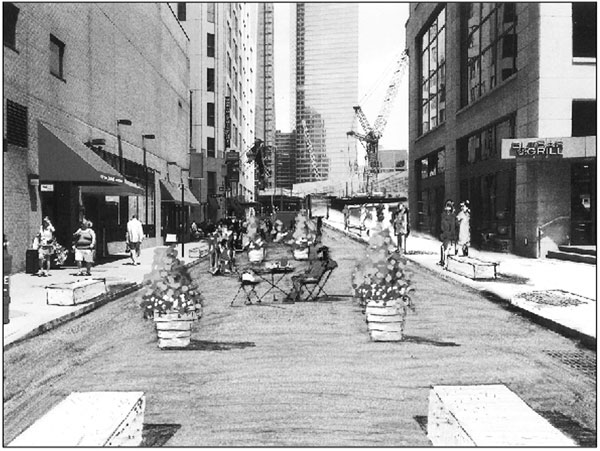BY ALINE REYNOLDS | Downtown residents, workers and tourists will soon have a new outdoor area to hang out in. To help relieve congestion around the National Sept. 11 Memorial, the city has plans to transform the strip of Washington Street between Albany and Carlisle Streets into a sprawling pedestrian plaza.
The plaza, which will be maintained by the Downtown Alliance Business Improvement District, will consist of chairs, tables and a tourism kiosk meant to encourage memorial visitors to linger in the area. The plan, an outgrowth of the Alliance’s study “Five Principals for Greenwich South,” is one of a series of initiatives to improve pedestrian mobility around the memorial’s temporary entrance, according to BID President Elizabeth Berger. The Washington Street plaza affords the BID the opportunity to launch its first-ever tourism kiosk, which will serve to direct tourists to neighborhood landmarks, she noted.
“One of the things that we looked at was how to capitalize on the old-world geometry of the street plan to create a sense of destination and gathering places,” she said. “There’ll be an attractive space not only for visitors but for people who live and work in the area to congregate.”
The area surrounding the memorial hasn’t realized its full potential, according to Jeffrey Mandel, a senior policy adviser for Robert Steele, the city’s deputy mayor for economic development. “We think it pushes a couple of big dominos forward by creating a place that’s not just attractive and desirable for the folks down here but that has beneficial impacts in the way of mitigation,” he said. “This is something we believe has a number of compelling virtues to enact now.”
The plaza will provide respite for the daily 10,000 to 15,000 memorial visitors who are clogging Downtown’s streets, according to Josh Krauss, a spokesperson for the city Department of Transportation. “Most often after they leave, they’re looking for a place to reflect, look at the rising skyline, pull out their Smartphones or maps and take stock of what they’ve seen and what they’ll see next,” he said. “In a way, that inconveniences the people in the neighborhood [by causing congestion].”
Work on the plaza, which was slated to take place this month, has been postponed due to Hurricane Sandy, and a new start date for construction wasn’t immediately clear. However, officials said it is only supposed to take a few days in total to complete.
In an e-mail Community Board 1 received during the first week of November, a D.O.T. official said, “The D.O.T.’s operational crews are currently devoted to disaster recovery work, so they will not be able to implement the plaza in November as planned. Once the work is complete, we will reevaluate the project timeline with an eye towards implementation as soon as conditions — particularly the weather — permit.”
At C.B. 1’s Wed., Oct. 17 Executive Committee meeting, however, the city officials, stressed the urgency to build and open the plaza before the year’s end, since it’s difficult to lay down gravel once it turns cold outside, according to Mandel. “We’re working on a fuse — this is our window in time,” he said. “If we wait ‘till next year, we’re not sure we can do this.”
The rerouting of the traffic from Washington Street to Albany Street will cause the city to increase the green time of the Albany Street traffic signal by 46 percent to help minimize traffic back-ups there. “In our observation, Washington Street is not heavily trafficked — the issue is how cars move on Albany Street,” said Berger. “That’s why we think this change in the signal is a good thing.”
Several members of Community Board 1’s Executive Committee praised the plan, including the McVay Hughes, who called it “a temporary solution to a temporary problem.”
“It was at the last Executive Committee that we had a five-page resolution on the lasting impact of tourism to our community,” she said. “So this is an incredible turn-around of time, energy and money devoted to improving the area.”
“I think this is a great addition,” echoed committee member Roger Byrom.
Others, however, expressed concern about the plan. Committee member Tom Goodkind said he is wary of pedestrian plazas in the vicinity of the W.T.C., as they create the need to close roadways. “Do we want the W.T.C. area to be, as they called it, a campus? Or do we want [streets] to run through?” he asked rhetorically.


















